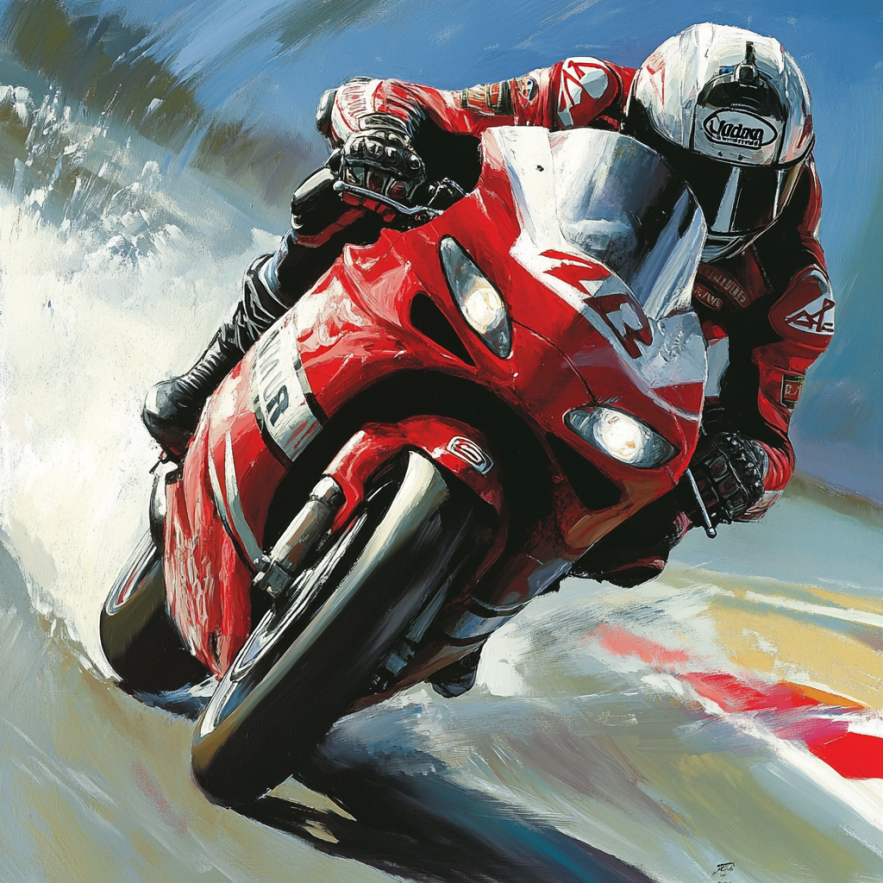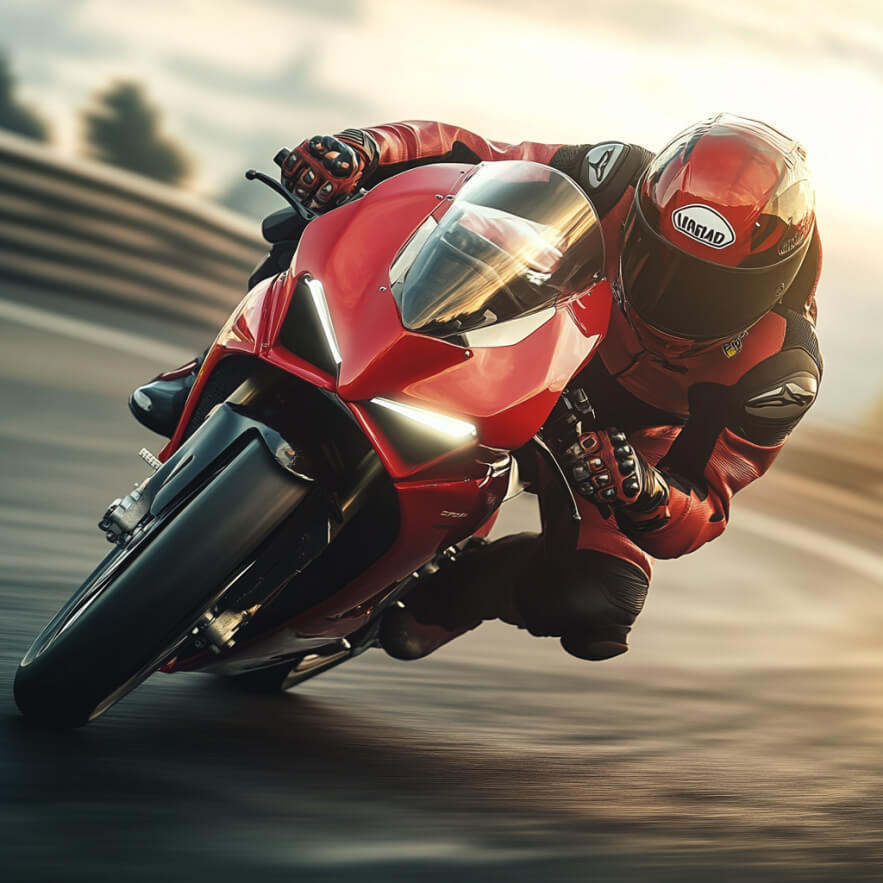Motorcycling is not only about high speeds and powerful motorbikes, but also a delicate tactical game of precision, coolness and the ability to adapt instantly to race conditions. Each rider uses their own strategies and techniques to take the lead, control the race and minimise the risks.
The development of racing techniques and strategies is largely due to advances in motorbike design, handling, aerodynamics and technology. Let’s look at an analysis of the strategies, manoeuvres and racing techniques that help riders dominate the track. We’ll look at basic tactics, effective overtaking, how to keep control of the bike and the balance between speed and safety.
Strategies in motorcycle racing
Winning a race rarely depends solely on speed. Even the fastest motorcycle cannot guarantee success if the rider does not know how to properly distribute energy, analyze competitors’ behavior, and manage the bike’s resources.Key elements of strategy in motorcycle racing:
- Choosing the optimal racing line. Riders meticulously study the track and select movement paths that minimize speed loss in turns and provide the best overtaking opportunities.
- Pacing and resource management. Controlling race pace without overloading the engine and tires is particularly important in long-distance races. A rider must know when to attack and when to conserve tires, fuel, and physical energy.
- Applying psychological pressure on rivals. Skilled riders create the illusion of attack, provoking opponents into mistakes. They shift their trajectories, approach dangerously close, or execute fake maneuvers.
- Flexibility and adaptation. Road conditions, asphalt texture, rain, or strong winds can radically alter the course of a race. Those who quickly adjust to new conditions gain a significant advantage.
Example of a strategic victory: In MotoGP and other motorcycle racing series, it is common to see leading riders deliberately slowing the pace to preserve their tires for a final attack at the crucial moment. Such strategic moves require cold-blooded calculation and experience.

Maneuvers and tactical moves
Motorcycle racing is highly dynamic, where every movement matters. A mistake in executing a maneuver can cost a rider their position—or even their participation in the race.
Types of Offensive Maneuvers
- Late braking. One of the most popular overtaking techniques: the rider brakes later than the opponent before entering the corner, taking an inside trajectory. This is a risky but effective way to gain a position.
- Using the slipstream. On straight sections of the track, riders position themselves behind a competitor to reduce aerodynamic drag. Then, by gaining extra speed, they perform a sharp pass forward.
- Counterattack in a turn. Even if an opponent has successfully overtaken, an experienced rider can use their trajectory and regain position by redistributing weight and accelerating at the right moment.
- Crossover overtake. Entering a turn with a wider trajectory forces the opponent into a mistake, allowing the rider to cut inside and pass on the exit.
Defensive tactical moves
- Blocking the racing line. A rider shifts toward the inside of a turn, leaving no room for an overtake attempt. This helps maintain position but requires precise speed control.
- Faking a maneuver. Sudden but controlled movements can trick an opponent into making a mistake, opening an opportunity for a counterattack.
- Changing pace. Riders sometimes adjust their rhythm unexpectedly, forcing competitors to react impulsively and potentially lose control.
Important: Every maneuver must be executed with precision and consideration, as a poorly timed attack can lead to a crash. The best riders always find a balance between aggression and safety.
Racing techniques: The balance of speed and control
A rider’s mastery is not just in speed but in the ability to control the motorcycle in extreme conditions. Proper handling minimizes losses in every track section and ensures stability in challenging situations.
The art of braking
Effective braking is a key factor in fast cornering. Several braking techniques are used in professional racing:
- Trail braking. The rider continues braking even after entering a turn, maintaining front-wheel grip and allowing for a higher entry speed.
- Combined braking. Using both front and rear brakes helps stabilize the motorcycle and prevent skidding.
- Two-finger braking. This method enables simultaneous control of both throttle and brakes, improving reaction time for trajectory adjustments.
Weight and balance management
A motorcycle remains manageable at high speeds only when the rider properly distributes their weight.
- Body shifting in turns. Moving the center of gravity inward reduces the motorcycle’s lean angle, improving traction.
- Counter-steering. To turn, the rider applies slight pressure on the handlebar in the opposite direction of the turn. This technique helps adjust the trajectory faster.
Throttle control. Smooth throttle application when exiting a turn prevents wheel slip and ensures effective acceleration.
Surface and grip adaptation
The track surface directly affects motorcycle behavior. Experienced riders know how to adjust to different terrains:
- On smooth asphalt, aggressive throttle and braking can be used more freely.
- On dusty or wet sections, grip control is crucial, and sudden movements should be avoided.
- On bumpy race tracks, braking and turn-in techniques require extreme precision.
Conclusion: The art of handling a motorcycle lies in constantly balancing risk and control. The best riders anticipate the bike’s response and make split-second adjustments to their riding technique.
These strategies, maneuvers, and techniques help riders outpace competitors, avoid crashes, and achieve victory. In the next section, we will explore risk and safety in motorsports and ways to minimize dangers on the track.
The most common tactical techniques include late braking, using the slipstream, counterattacking in a turn, and crossover overtaking. These methods allow for safe and effective passing.
The key strategies include choosing the optimal racing line, controlling race pace, managing tire wear, and adapting to changing conditions. These factors help riders minimize speed loss and execute efficient attacks
They use braking techniques (trail braking, combined braking), body weight shifting in turns, counter-steering, and smooth throttle control. These skills help riders maintain motorcycle stability even at extreme speeds.

